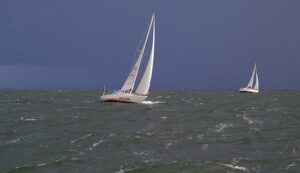The relative motion is a motion of an object with respect to another frame of reference.
Suppose the object is moving at velocity v1 and another object is moving away from that object with velocity v2, then the relative velocity of both the object in their frame of reference will be the addition of both the velocities. Here is a list of relative motion examples:-
The Passenger in a Bus
The passenger standing in a bus in a stationary position but the relative motion of the passengers in a bus is equal to the velocity of the bus.
The passengers are moving along with the bus with the displacement equal to the rate of displacement of the bus.
A Person walking in a Train in a Forward Direction
The speed of a person walking in a train is relative to the speed of the moving train. The walking speed of the person would be a, but in another frame of reference for the observer standing outside the train the speed of the person is relative to the train. Since the person is moving forward direction with the moving train velocity b then the relative velocity of the man is a+b.
The Table moved with a Stack of Books on It
The stack of books is at rest, hence the velocity of the book with the reference point on the table is zero. But for viewers, the velocity of the books is relative to the speed of the table.

Passengers on the Roller Coaster
The passenger sitting on a roller coaster will see that the other passengers are stationary and not moving in his frame of reference.

The relative motion of the passenger with the frame of reference of another passenger is zero. But the actual speed of the passenger is relative to the speed of the roller coaster.
The Vehicle Close by Moved in the Backward Direction
You must have noticed sitting in a vehicle if another vehicle standing stationary moves ahead then as per your frame of reference you feel that the vehicle in which you are sitting is taken backward. If the same vehicle is taken in the backward direction, it appears as if your vehicle is moved forward and vice versa.
A Boat Floating on Water
A boat floating on the water appears to be stationary with the frame of reference of the ocean waves.

For a person standing in a boat in open water, it appears to him that the boat is stationary because his relative speed matches the speed of the boat.
Marching
For a person marching in a group, the speed of the other marchers in a group in his frame of reference is zero because all the members are moving at the same speed and hence appear stationary.
Two Friends Walking Together
If the two friends are walking together at the same speed then the relative velocity of both with respect to each other will be zero.

Another person watching them from a far distance will see the positive velocity of both the friends.
Clock in the Bus
A clock in the bus is moving with the relative speed of the bus. A clock is actually stationary fixed at one point. For any point of reference from the bus, the velocity of a clock is zero, but for a point of reference outside the bus, the velocity of a clock is relative to the velocity of the bus.
Bicyclist Riding in the Rain
If the bicyclist riding a cycle in a rain at a certain velocity, he will notice that the speed of the rain is more than the actual speed of the raindrops. For his point of reference, the relative velocity of the raindrop is the velocity of the raindrop plus his velocity hence he feels that the speed of the rain is more than the actual.
Skiing
The relative velocity of the skiboard in the reference point of the skier is zero because he is standing on the board which is moving along with him.

Well for another reference point the relative velocity of the skier is relative to the board.
Geostationary Satellite
The geostationary satellites are those mounted 36,000 km above the surface of the Earth and the speed of the satellite is in sync with the speed of the Earth. Hence, the speed of the geostationary satellite from the reference point of the earth and the satellite appears to be zero.
Kayaking
The relative speed of the kayak depends upon the speed of the water current. If the kayak moves in the direction of the current then the relative speed of the kayak will be the addition of the speed of water flow and the kayak, in contrary, if the kayak is traveling in the direction opposite to the flow of water then the relative speed of kayak will reduce.
Swimming
If the ocean waves are approaching the swimmer, the relative velocity of the swimmer will be lower than his actual velocity.
For a swimmer, it will appear that he is moving faster but the speed of the waves decreases the velocity of the swimmer.
Riding in Helicopter
The relative motion of a person sitting in a helicopter is equal to the speed of the helicopter because the person is in a stationary position.
Sitting on a Swing
The speed of a girl sitting on a swing is in relative motion with the oscillating swing.

A girl is sitting stationary on the swing and her actual velocity is zero. But since she is in motion along with the swing, her relative velocity is equal to the velocity of a swing.
A Ball Passed to the Player Approaching Towards Him
For the player who is passing the ball, the velocity of a ball will be the actual velocity, but for a catcher who is approaching the ball, for him, the velocity will be more than the actual. The relative velocity in his point of reference is the addition of the velocity of a ball and his running speed towards the ball.
A Vehicle Crossing a Bicycle Rider and a Car
For a car driver, the relative velocity of a vehicle will be more compared to the relative velocity with respect to the bicyclist. This is because the speed of a car is more than the bicycle. For two objects appearing towards each other, the velocities add up.
Mobile Kept in a Pocket while Walking
The relative velocity of mobile is equal to the walking speed. Mobile in a pocket is stationary with a reference point of a carrier.
Object Released from the Moving Car
Any object thrown out from a running car moves backward from the car because the car is moving forward and hence with the frame of reference of a person sitting in a car, he will see that the object is moving backward.
Frequently Asked Questions
What is the relative speed of a bicyclist moving with a speed of 4m/s and a car at a speed of 75km/h moving away from each other?
Given: Speed of car V1=75km/h= 20.83m/s
Speed of man V2=4m/s
Hence, the relative speed of two diverging objects is
V=V1-V2
V=20.83+4=24.83 m/s
The relative speed between the two is 24.83 m/s.
What is the relative velocity of a kayak riding at a speed of 10 m/s against the river current of the speed of 8m/s?
Given: Speed of kayak V1=10m/s
Speed of river V2=8m/s
Hence, the relative speed of the kayak is
V=V1-V2
V=10-8=2 m/s
The relative speed between the two is 2 m/s.
Also, click to read more on 15+ Reciprocating Motion Examples.
Also Read:
- Passive range of motion examples
- Uniformly accelerated motion
- Brownian motion examples
- Simple harmonic motion examples
- Example of inertia of motion
- Range of motion examples
- Displacement in circular motion
- Lens for capturing fast motion
- Non uniform circular motion examples
- Linear motion examples
Hi, I’m Akshita Mapari. I have done M.Sc. in Physics. I have worked on projects like Numerical modeling of winds and waves during cyclone, Physics of toys and mechanized thrill machines in amusement park based on Classical Mechanics. I have pursued a course on Arduino and have accomplished some mini projects on Arduino UNO. I always like to explore new zones in the field of science. I personally believe that learning is more enthusiastic when learnt with creativity. Apart from this, I like to read, travel, strumming on guitar, identifying rocks and strata, photography and playing chess.